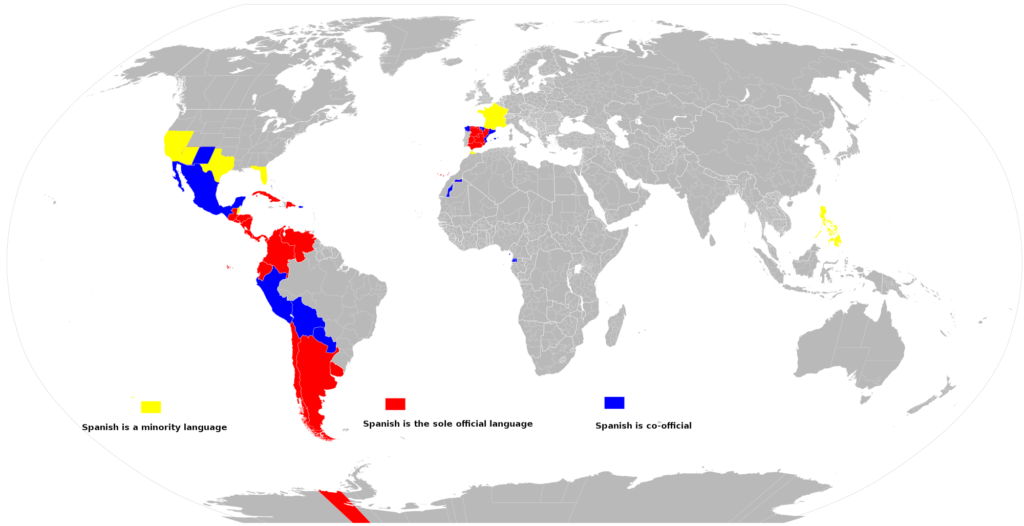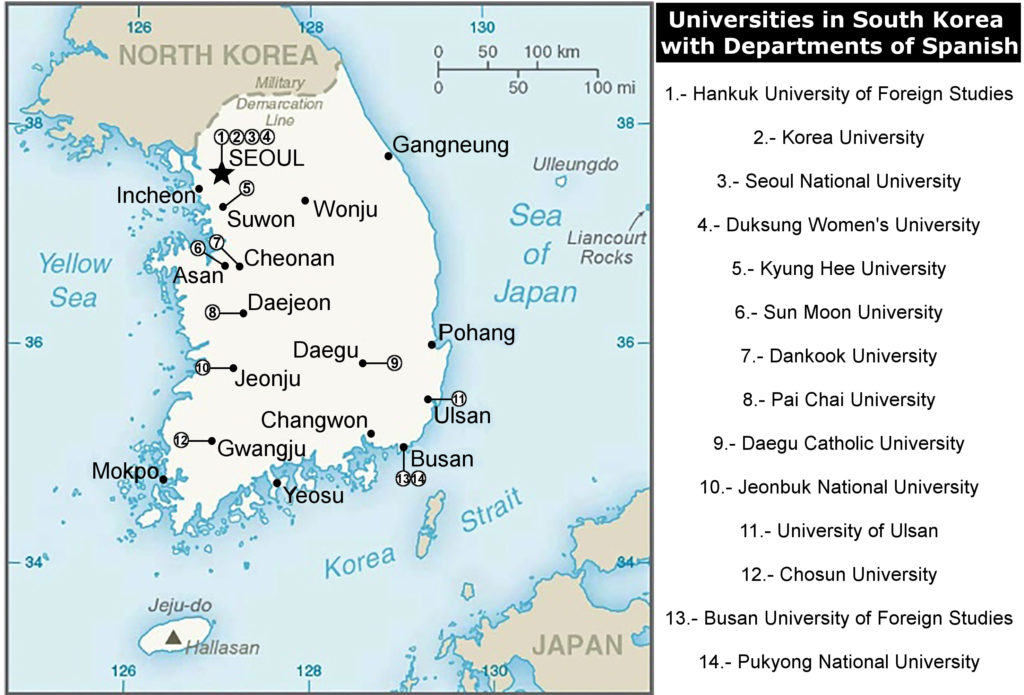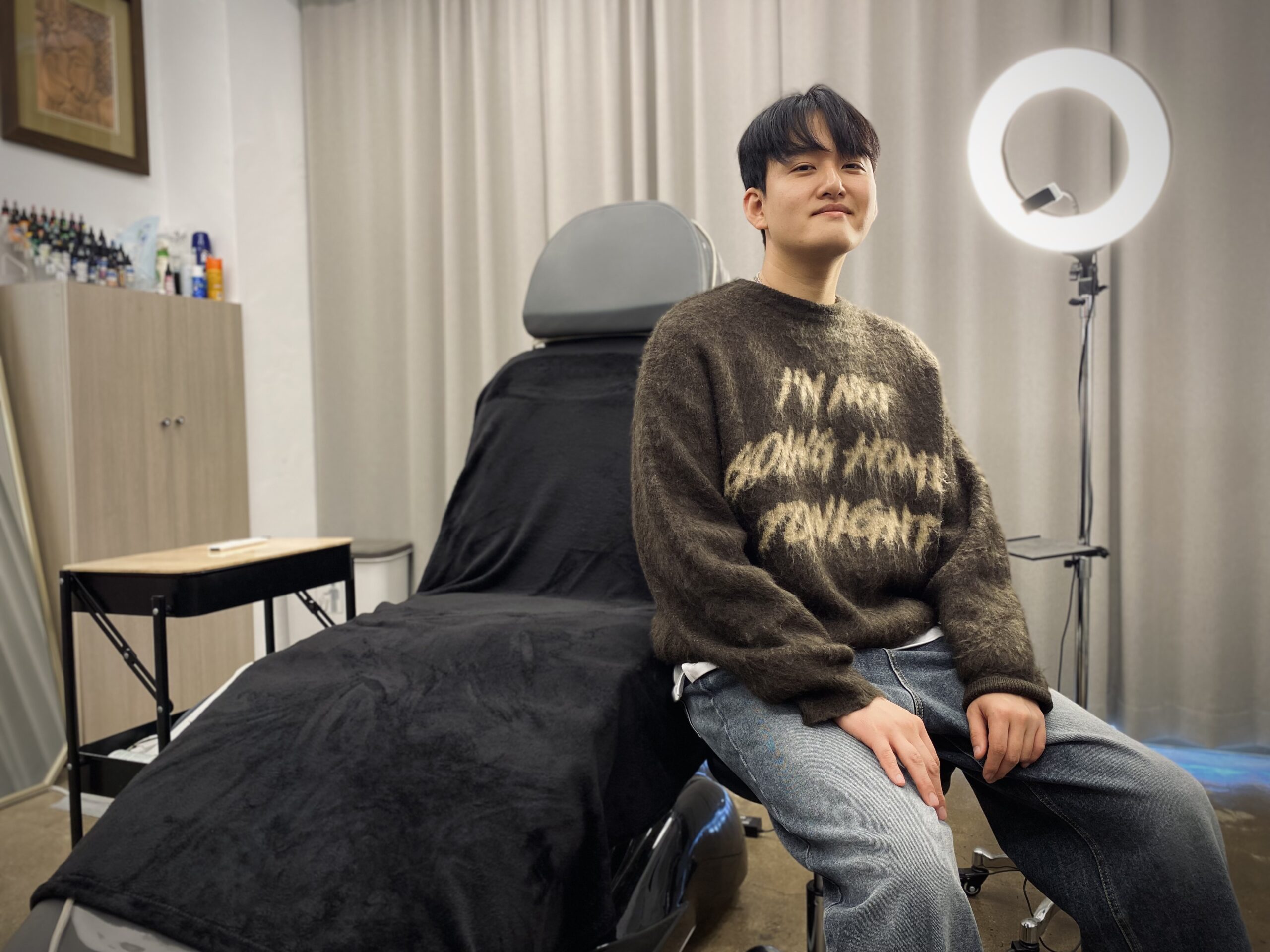Spanish in South Korea
A Language of New Opportunities
Written by José Avila Peltroche and Elisabet Ramirez.
Spanish, also called Castilian due to its origin in the Spanish Kingdom of Castile, is a romance language from the Iberian Peninsula. More than 577 million people around the world (7.6 percent of the world’s population) speak Spanish as a first or second language. By the number of native speakers, it is the second most spoken language worldwide after Mandarin Chinese. Spanish is one of the six official languages of the United Nations (UN) and also of some other important political-economic organizations (e.g., the European Union and the Antarctic Treaty System). Spanish is also the third most used language on the Internet. Like other romance languages, it is a modern continuation of the “colloquial Latin” (also called “vulgar Latin”) that started diversifying in the 3rd and 4th centuries CE. It diverged from other variants of Latin after the fall of the Roman Empire in the 5th century CE.

To date, Spanish is the romance language that has achieved the highest diffusion across the globe, thanks to its propagation during the Spanish colonization period (15th–19th centuries), especially in the Americas.[1] Spanish has also strongly influenced some creole languages. For instance, Chavacano (or Chabacano) is a Spanish-based creole language spoken in the Philippines, which itself presents variations depending on the area where it is spoken. Another good example is Palenquero, spoken primarily in the village of San Basilio de Palenque in northern Colombia.[2]
One of the oldest Spanish loanwords in the Korean language is tabaco (“tobacco” in English). It entered the Korean Peninsula during the Japanese invasions in the 16th century. This word experienced many phonetic changes during the following centuries, and nowadays, it is pronounced dambae (담배).[3] Despite this old record, Spanish teaching in South Korea just started 72 years ago. In April 1948, Dongyang Institute for Foreign Languages was founded, and it originally taught six languages: English, French, German, Chinese, Russian, and for the first time, Spanish. However, this project was thwarted due to the Korean War (1950–1953). It was not until 1955 when the first department of Spanish language, at Hankuk University of Foreign Studies, was inaugurated.

According to the Korean Ministry of Education, in 2005, the number of people learning Spanish in South Korea was approximately 15,000. There are currently 30 universities where Spanish is taught as a second language, 14 of which have their own Department of Spanish Language and Literature. Also, 41 high school institutes offer it as an optional subject, and four high schools as a mandatory subject.[4] Interestingly, South Korea is the country in Asia having the highest number of students enrolled in the Diplomas de Español como Lengua Extranjera (DELE; English: Diplomas of Spanish as a Foreign Language) exam. The DELE is a world-recognized certificate of proficiency and fluency in Spanish. In 2010, more than 2,000 Korean students decided to take the DELE exam, 70 percent of them being women.[3]
Nowadays, Spanish is the most required Western language in South Korea after English. The popularity of Spanish in the country can be reflected in several aspects. With the expansion of South Korean companies around the world, such as Samsung and LG, have Spanish-speaking personnel gives them a competitive advantage in expanding their markets to places like Latin America. In fact, every summer, Seoul hosts the Latin American Festival, where music, dances, foods, along with other cultural expressions from countries in this region, are presented. An interesting example of how Spanish can connect places geographically distant from South Korea can be found in K-pop music. During the last few years, Korean bands have made collaborations with Latin artists and have included Spanish phrases in their songs. This is an effort to connect better with their fans in Spanish-speaking countries, which represent an important percentage of their sales.[5] Spanish words have also been used for naming products from different industries: LG called its new kimchi refrigerator dios (“God” in English), and Hyundai used tiburón (“shark” in English) for naming one of its sport car models.[3]

In Gwangju, Spanish is taught at some institutions. Chosun University is the only one having its own Department of Spanish Studies in the Jeollanam-do area.[4] The Gwangju International Center also offers Spanish classes to Gwangju citizens and expats. Despite the importance of this formal education while learning Spanish, informal activities, such as talking with native-speaker friends and acquaintances, are crucial to becoming fluent.[6] In this sense, the Gwangju Spanish Club was created in 2013 by Douglas Baumwoll, a US expat who learned Spanish in the Canary Islands (Spain), to bring native and non-native Spanish speakers together. Since 2019, twice a month the Gwangju International Center has hosted the Spanish Language Exchange organized by the Gwangju Spanish Club. The exchange has gathered people from countries like Mexico, Peru, Spain, Bolivia, Ecuador, the USA, Colombia, Haiti, the Philippines, and of course, South Korea. It offers a friendly place for practicing Spanish regardless of a person’s level, and it helps the Gwangju community connect with the different cultural backgrounds that Spanish-speaking countries have.

In summary, Spanish is still a young language in South Korea and is mostly spoken by minorities in this country. However, its expansion during the past seven decades has been extraordinary. Despite being still far behind other languages such as English and Chinese, the utility of Spanish in business and cultural exchanges attracts and will continue to attract more students of all ages. Spanish has become a door to new opportunities for Koreans to explore.
Sources
[1] Instituto Cervantes. (2018). 577 millones de personas hablan español, el 7,6 % de la población mundial. Cervantes Institute. https://www.cervantes.es/sobre_instituto_cervantes/prensa/2018/noticias/np_presentacion-anuario.htm
[2] Lipski, J. M. (2004). Las lenguas criollas de base hispana. Lexis: Revista de lingüística y literatura, 28(1/2), 461–508.
[3] Segura, J. J., & Cabrera-Sánchez, J. (2011). El español en Corea del Sur. El español en el mundo. Anuario 2010–2011. Cervantes Institute. https://cvc.cervantes.es/lengua/anuario/anuario_10-11/jimenez_cabrera/p01.htm
[4] Kwon, E. H. (2007). El español en Corea del Sur. Enciclopedia del español en el mundo. Anuario del Instituto Cervantes 2006-2007 (pp. 146–149). Instituto Cervantes.
[5] Rivas, J. (2018). El creciente interés de Corea por aprender español. K-magazine. https://www.k-magazinemx.com/el-creciente-interes-de-corea-por-aprender-espanol/
[6] Mendoza-Puertas, J. D. (2018). La educación informal en el aprendizaje del español entre los universitarios de Corea del Sur. Revista Internacional de Lenguas Extranjeras, 9, 55–75.
THE AUTHORS
Elisabet Ramirez is an environmental engineer from Queretaro, Mexico. She is a Spanish teacher in Gwangju. José and Elisabet are in charge of the Spanish Language Exchanges at the Gwangju International Center. Instagram:@elielir
Jose Avila Peltroche is a biologist from Lima, Peru. He is currently doing a PhD in seaweed biology at Chosun University in Gwangju.
Instagram: @jocavi89




